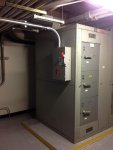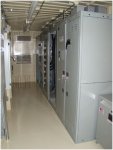sfav8r
Senior Member
- Location
- San Francisco Bay Area
We recently installed a disconnect as per the attached photo. The removable panel that we mounted our disconnect on is a removable panel which obviously is not removable after we added the disconnect. We took this into consideration at the time of install and decided that the since the panel below our disconnect is removable and the six panels on the back of the switch gear are removable, that the panel we mounted our disconnect on was not required for access. You can literally walk inside the switchgear to access anything that requires servicing. The inspector is saying that we cannot mount the panel there because (1) You cannot mount anything on switch gear, period. (2) Even if #1 didn't apply, you have effectively blocked access to the switch gear.
I have to say that I see his point (#2 anyway), but I don't completely agree. There is more than adaquate clearance and accessability even with our disconnect. The Inspector feels that because the manufacturer put the panel there then by default it has to remain accessible. I feel that the manufacturer puts access on all sides because they don't know where good access will be and where it will be blocked. A good example of that is parking garage arms and ticket spitters that have access panels on both sides because that way they can be installed with one side against a wall, either the left or the right works because no matter which side is against the wall you have access from the other side. There is no requirement to access from both sides just because the manufacturer put an access panel on both sides.
I have two questions. Does anyone know of a specif NEC reference that prohibits adding a disconnect to the switch gear as we have done? Do you think this installation is OK irrespective the NEC? That is to say weather it's "legal" or not, do you have issues with it?
Since I know everyone must be wondering, the reason we put it there is it was literall the only spot in the electrical room that met all of the clearance requirements. We needed to be within 25' due to tap rules.
Thanks for any input.
I have to say that I see his point (#2 anyway), but I don't completely agree. There is more than adaquate clearance and accessability even with our disconnect. The Inspector feels that because the manufacturer put the panel there then by default it has to remain accessible. I feel that the manufacturer puts access on all sides because they don't know where good access will be and where it will be blocked. A good example of that is parking garage arms and ticket spitters that have access panels on both sides because that way they can be installed with one side against a wall, either the left or the right works because no matter which side is against the wall you have access from the other side. There is no requirement to access from both sides just because the manufacturer put an access panel on both sides.
I have two questions. Does anyone know of a specif NEC reference that prohibits adding a disconnect to the switch gear as we have done? Do you think this installation is OK irrespective the NEC? That is to say weather it's "legal" or not, do you have issues with it?
Since I know everyone must be wondering, the reason we put it there is it was literall the only spot in the electrical room that met all of the clearance requirements. We needed to be within 25' due to tap rules.
Thanks for any input.


